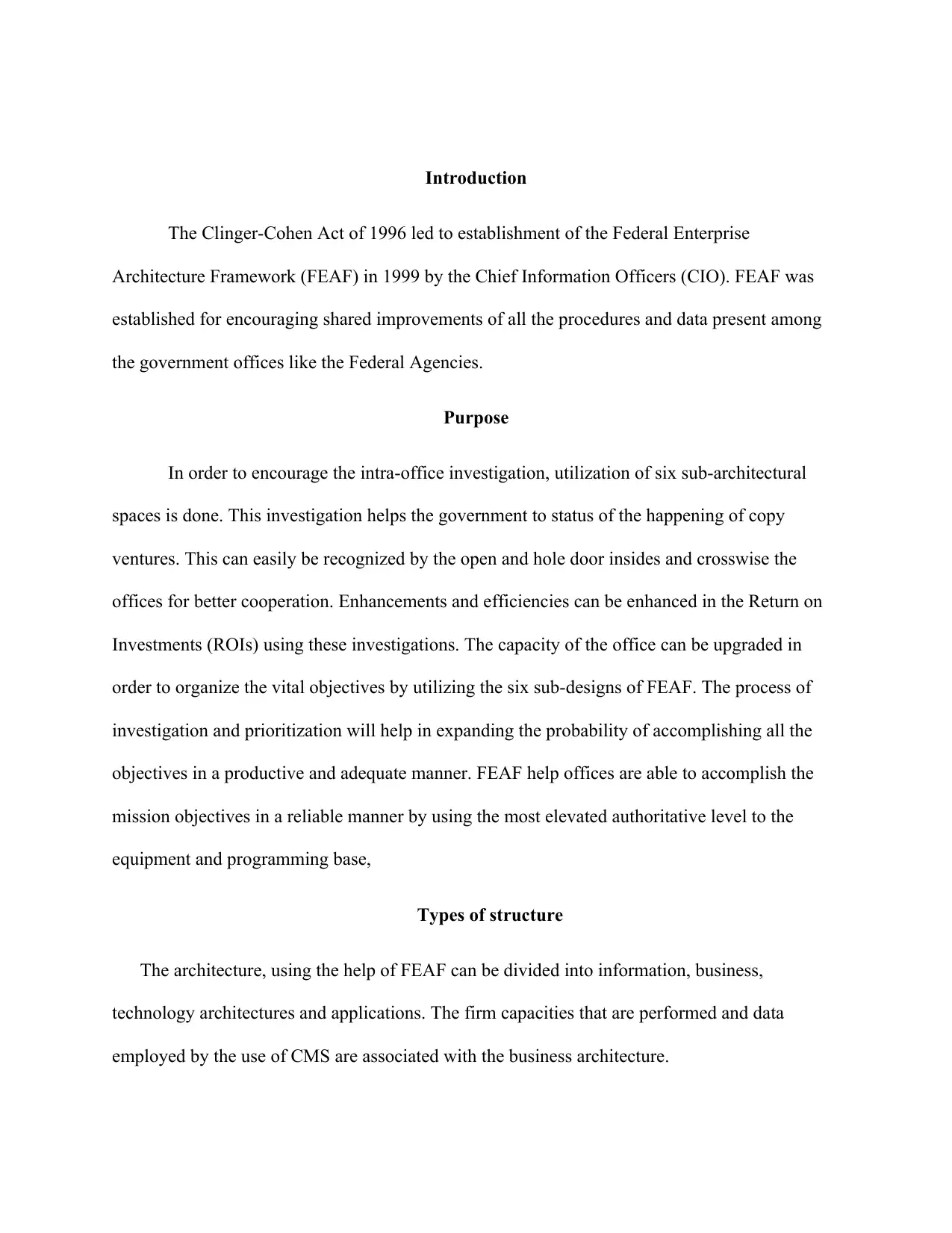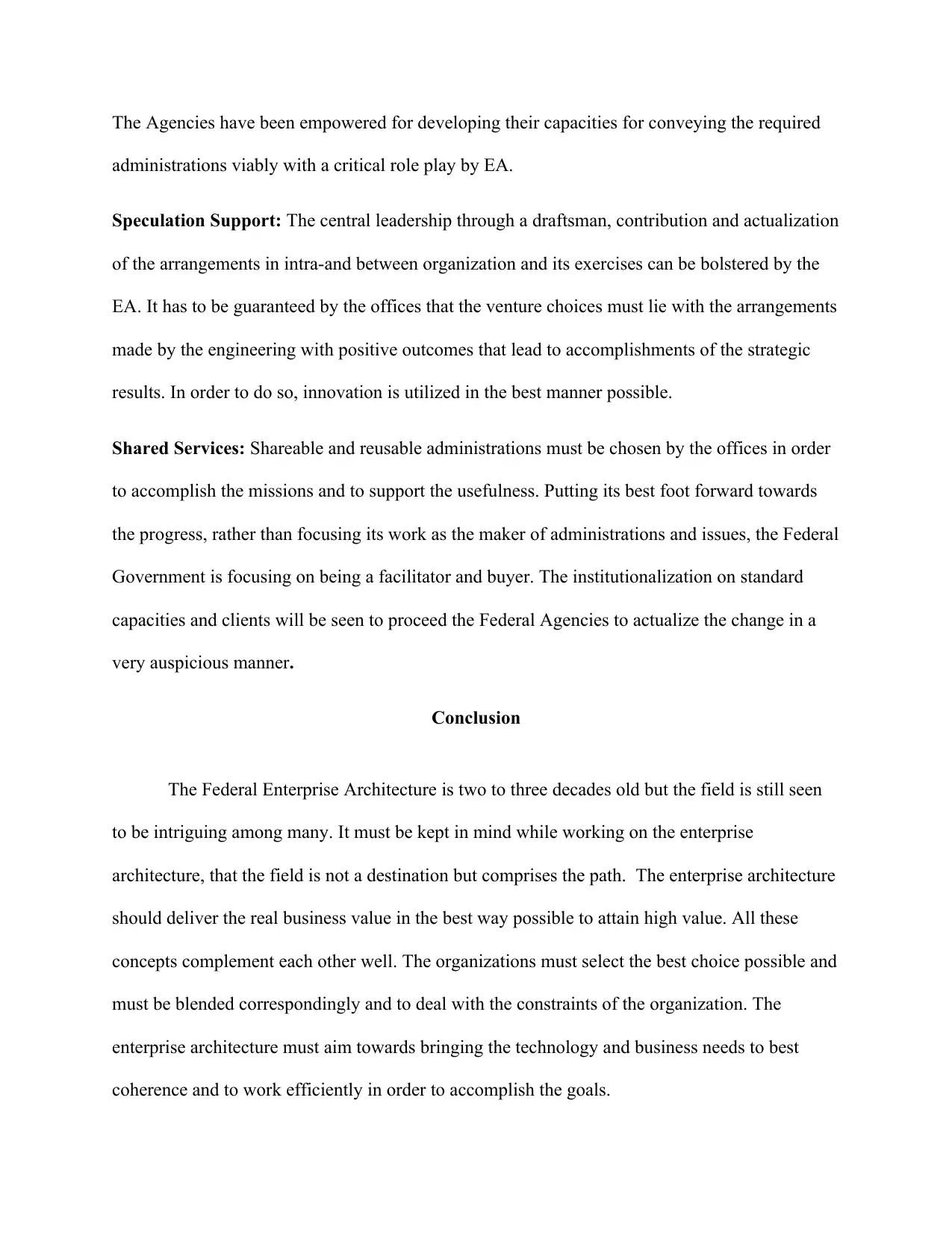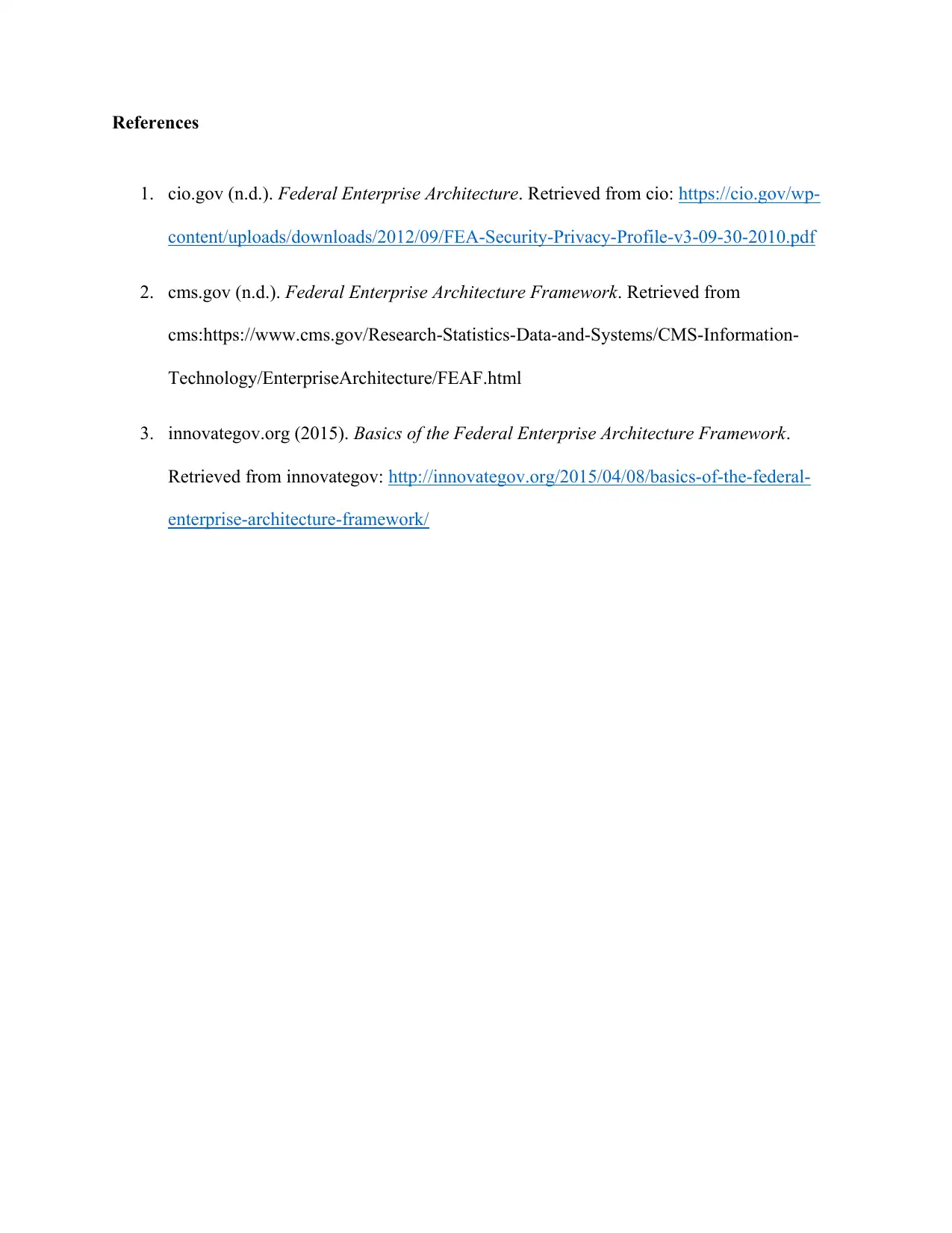Analyzing the Federal Enterprise Architecture Framework (FEAF) Report
VerifiedAdded on 2019/09/30
|5
|1069
|37
Report
AI Summary
This report provides an in-depth analysis of the Federal Enterprise Architecture Framework (FEAF), established by the CIO in 1999 under the Clinger-Cohen Act. The FEAF aims to improve data and procedures across federal agencies through six sub-architectural spaces, fostering intra-office investigation and collaboration. The report details the framework's purpose, which includes enhancing Return on Investments (ROIs) and aligning agency objectives. It outlines the four types of architecture: business, data, application, and technology, and describes the eight levels of engineering execution. The report also covers FEAF principles such as a common approach, future-readiness, investment support, and shared services. The conclusion emphasizes that enterprise architecture is an ongoing process, not a destination, and should focus on delivering real business value by aligning technology and business needs to achieve organizational goals. The report includes references to relevant government websites and resources.

Introduction
The Clinger-Cohen Act of 1996 led to establishment of the Federal Enterprise
Architecture Framework (FEAF) in 1999 by the Chief Information Officers (CIO). FEAF was
established for encouraging shared improvements of all the procedures and data present among
the government offices like the Federal Agencies.
Purpose
In order to encourage the intra-office investigation, utilization of six sub-architectural
spaces is done. This investigation helps the government to status of the happening of copy
ventures. This can easily be recognized by the open and hole door insides and crosswise the
offices for better cooperation. Enhancements and efficiencies can be enhanced in the Return on
Investments (ROIs) using these investigations. The capacity of the office can be upgraded in
order to organize the vital objectives by utilizing the six sub-designs of FEAF. The process of
investigation and prioritization will help in expanding the probability of accomplishing all the
objectives in a productive and adequate manner. FEAF help offices are able to accomplish the
mission objectives in a reliable manner by using the most elevated authoritative level to the
equipment and programming base,
Types of structure
The architecture, using the help of FEAF can be divided into information, business,
technology architectures and applications. The firm capacities that are performed and data
employed by the use of CMS are associated with the business architecture.
The Clinger-Cohen Act of 1996 led to establishment of the Federal Enterprise
Architecture Framework (FEAF) in 1999 by the Chief Information Officers (CIO). FEAF was
established for encouraging shared improvements of all the procedures and data present among
the government offices like the Federal Agencies.
Purpose
In order to encourage the intra-office investigation, utilization of six sub-architectural
spaces is done. This investigation helps the government to status of the happening of copy
ventures. This can easily be recognized by the open and hole door insides and crosswise the
offices for better cooperation. Enhancements and efficiencies can be enhanced in the Return on
Investments (ROIs) using these investigations. The capacity of the office can be upgraded in
order to organize the vital objectives by utilizing the six sub-designs of FEAF. The process of
investigation and prioritization will help in expanding the probability of accomplishing all the
objectives in a productive and adequate manner. FEAF help offices are able to accomplish the
mission objectives in a reliable manner by using the most elevated authoritative level to the
equipment and programming base,
Types of structure
The architecture, using the help of FEAF can be divided into information, business,
technology architectures and applications. The firm capacities that are performed and data
employed by the use of CMS are associated with the business architecture.
Paraphrase This Document
Need a fresh take? Get an instant paraphrase of this document with our AI Paraphraser

The characterisation of putting away, utilizing as the framework part or overseeing the
information is done using the data structure. This helps in setting up regular information
operations which would make it conceivable for modelling, anticipating as well as
controlling the information in the concise frame.
The application architecture is seen to be comprised of the intelligent framework dealing
with the information objects especially in the field of information engineering and is also
seen to back the Business Architecture and its business capacities. The characterization of
the application takes place without referring to certain advancements. After a period of
time it is observed that the applications gets constant and steady in nature and the
exaction of the innovation will be changed over a long period of time keeping in mind the
business needs which are evolving and easily available.
The present and future specialized foundation can easily be depicted by the Technology
Architecture along with the innovations in programming the will be seen to support the
data framework of the CMS.
Scope
Using the conventional approach, eight level of degrees are present for the engineering
execution, namely:
International
Federal
National
Agency
System
information is done using the data structure. This helps in setting up regular information
operations which would make it conceivable for modelling, anticipating as well as
controlling the information in the concise frame.
The application architecture is seen to be comprised of the intelligent framework dealing
with the information objects especially in the field of information engineering and is also
seen to back the Business Architecture and its business capacities. The characterization of
the application takes place without referring to certain advancements. After a period of
time it is observed that the applications gets constant and steady in nature and the
exaction of the innovation will be changed over a long period of time keeping in mind the
business needs which are evolving and easily available.
The present and future specialized foundation can easily be depicted by the Technology
Architecture along with the innovations in programming the will be seen to support the
data framework of the CMS.
Scope
Using the conventional approach, eight level of degrees are present for the engineering
execution, namely:
International
Federal
National
Agency
System

Application
Sector
The consistency has been advanced by these degree levels for improvements of the
equivalence along with back shifting the levels in the various quality sides in the engineering
techniques. A varying degree of design ranges can be seen which range widely, starting from the
one or more state perspectives to the detailed aspects like application, framework and fragment.
A plethora of degree levels are important for creating viable structure supporting the objectives
and missions of the organizations due to the nature of working of the U.S. National Government
works. FEA Program Management Office (FEAPMO) has been supporting the extra level of
government undertaking designs enveloping the business activities of the multi-line and multi-
office. The broad design activities and segments will be obliged by these levels which also
includes the State, Local, and Tribal offices and their partners along with as scholastic, industry,
and universal gatherings. FEAPMO needs to direct the engineering techniques for creating the
security and protection controls for new levels of extension.
Principles
Common Approach to Federal EA and its general standards have been accompanied and
the criteria weighing the potential speculation and engineering choices have also been spoken
agaianst.
Future-Ready: Federal Government is seen to be in an active state by receiving help from EA in
order to complete the missions on which the Nation is relying. The necessities and prerequisites
of the mission are seen to be changed persistently and a constrained has been seen in the assets.
Sector
The consistency has been advanced by these degree levels for improvements of the
equivalence along with back shifting the levels in the various quality sides in the engineering
techniques. A varying degree of design ranges can be seen which range widely, starting from the
one or more state perspectives to the detailed aspects like application, framework and fragment.
A plethora of degree levels are important for creating viable structure supporting the objectives
and missions of the organizations due to the nature of working of the U.S. National Government
works. FEA Program Management Office (FEAPMO) has been supporting the extra level of
government undertaking designs enveloping the business activities of the multi-line and multi-
office. The broad design activities and segments will be obliged by these levels which also
includes the State, Local, and Tribal offices and their partners along with as scholastic, industry,
and universal gatherings. FEAPMO needs to direct the engineering techniques for creating the
security and protection controls for new levels of extension.
Principles
Common Approach to Federal EA and its general standards have been accompanied and
the criteria weighing the potential speculation and engineering choices have also been spoken
agaianst.
Future-Ready: Federal Government is seen to be in an active state by receiving help from EA in
order to complete the missions on which the Nation is relying. The necessities and prerequisites
of the mission are seen to be changed persistently and a constrained has been seen in the assets.
⊘ This is a preview!⊘
Do you want full access?
Subscribe today to unlock all pages.

Trusted by 1+ million students worldwide

The Agencies have been empowered for developing their capacities for conveying the required
administrations viably with a critical role play by EA.
Speculation Support: The central leadership through a draftsman, contribution and actualization
of the arrangements in intra-and between organization and its exercises can be bolstered by the
EA. It has to be guaranteed by the offices that the venture choices must lie with the arrangements
made by the engineering with positive outcomes that lead to accomplishments of the strategic
results. In order to do so, innovation is utilized in the best manner possible.
Shared Services: Shareable and reusable administrations must be chosen by the offices in order
to accomplish the missions and to support the usefulness. Putting its best foot forward towards
the progress, rather than focusing its work as the maker of administrations and issues, the Federal
Government is focusing on being a facilitator and buyer. The institutionalization on standard
capacities and clients will be seen to proceed the Federal Agencies to actualize the change in a
very auspicious manner.
Conclusion
The Federal Enterprise Architecture is two to three decades old but the field is still seen
to be intriguing among many. It must be kept in mind while working on the enterprise
architecture, that the field is not a destination but comprises the path. The enterprise architecture
should deliver the real business value in the best way possible to attain high value. All these
concepts complement each other well. The organizations must select the best choice possible and
must be blended correspondingly and to deal with the constraints of the organization. The
enterprise architecture must aim towards bringing the technology and business needs to best
coherence and to work efficiently in order to accomplish the goals.
administrations viably with a critical role play by EA.
Speculation Support: The central leadership through a draftsman, contribution and actualization
of the arrangements in intra-and between organization and its exercises can be bolstered by the
EA. It has to be guaranteed by the offices that the venture choices must lie with the arrangements
made by the engineering with positive outcomes that lead to accomplishments of the strategic
results. In order to do so, innovation is utilized in the best manner possible.
Shared Services: Shareable and reusable administrations must be chosen by the offices in order
to accomplish the missions and to support the usefulness. Putting its best foot forward towards
the progress, rather than focusing its work as the maker of administrations and issues, the Federal
Government is focusing on being a facilitator and buyer. The institutionalization on standard
capacities and clients will be seen to proceed the Federal Agencies to actualize the change in a
very auspicious manner.
Conclusion
The Federal Enterprise Architecture is two to three decades old but the field is still seen
to be intriguing among many. It must be kept in mind while working on the enterprise
architecture, that the field is not a destination but comprises the path. The enterprise architecture
should deliver the real business value in the best way possible to attain high value. All these
concepts complement each other well. The organizations must select the best choice possible and
must be blended correspondingly and to deal with the constraints of the organization. The
enterprise architecture must aim towards bringing the technology and business needs to best
coherence and to work efficiently in order to accomplish the goals.
Paraphrase This Document
Need a fresh take? Get an instant paraphrase of this document with our AI Paraphraser

References
1. cio.gov (n.d.). Federal Enterprise Architecture. Retrieved from cio: https://cio.gov/wp-
content/uploads/downloads/2012/09/FEA-Security-Privacy-Profile-v3-09-30-2010.pdf
2. cms.gov (n.d.). Federal Enterprise Architecture Framework. Retrieved from
cms:https://www.cms.gov/Research-Statistics-Data-and-Systems/CMS-Information-
Technology/EnterpriseArchitecture/FEAF.html
3. innovategov.org (2015). Basics of the Federal Enterprise Architecture Framework.
Retrieved from innovategov: http://innovategov.org/2015/04/08/basics-of-the-federal-
enterprise-architecture-framework/
1. cio.gov (n.d.). Federal Enterprise Architecture. Retrieved from cio: https://cio.gov/wp-
content/uploads/downloads/2012/09/FEA-Security-Privacy-Profile-v3-09-30-2010.pdf
2. cms.gov (n.d.). Federal Enterprise Architecture Framework. Retrieved from
cms:https://www.cms.gov/Research-Statistics-Data-and-Systems/CMS-Information-
Technology/EnterpriseArchitecture/FEAF.html
3. innovategov.org (2015). Basics of the Federal Enterprise Architecture Framework.
Retrieved from innovategov: http://innovategov.org/2015/04/08/basics-of-the-federal-
enterprise-architecture-framework/
1 out of 5
Related Documents
Your All-in-One AI-Powered Toolkit for Academic Success.
+13062052269
info@desklib.com
Available 24*7 on WhatsApp / Email
![[object Object]](/_next/static/media/star-bottom.7253800d.svg)
Unlock your academic potential
Copyright © 2020–2025 A2Z Services. All Rights Reserved. Developed and managed by ZUCOL.




